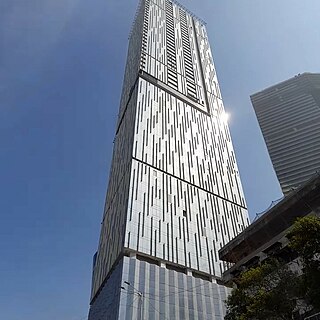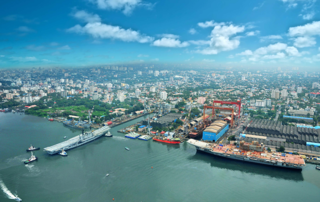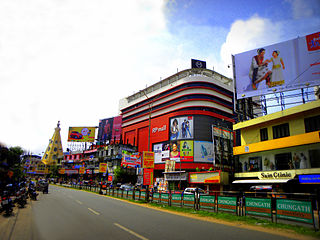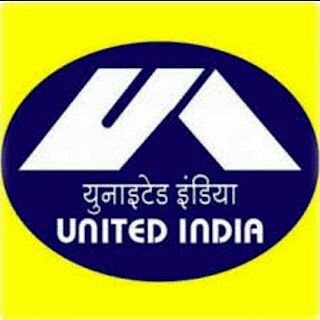Related Research Articles

A corporation is an organization—usually a group of people or a company—authorized by the state to act as a single entity and recognized as such in law for certain purposes. Early incorporated entities were established by charter. Most jurisdictions now allow the creation of new corporations through registration. Corporations come in many different types but are usually divided by the law of the jurisdiction where they are chartered based on two aspects: whether they can issue stock, or whether they are formed to make a profit. Depending on the number of owners, a corporation can be classified as aggregate or sole.

The economy of Israel is a highly developed free-market economy. The prosperity of Israel's advanced economy allows the country to have a sophisticated welfare state, a powerful modern military said to possess a nuclear-weapons capability with a full nuclear triad, modern infrastructure rivaling many Western countries, and a high-technology sector competitively on par with Silicon Valley. It has the second-largest number of startup companies in the world after the United States, and the third-largest number of NASDAQ-listed companies after the U.S. and China. American companies, such as Intel, Microsoft, and Apple, built their first overseas research and development facilities in Israel. More than 400 high-tech multi-national corporations, such as IBM, Google, Hewlett-Packard, Cisco Systems, Facebook and Motorola have opened R&D centers throughout the country. As of 2024, the IMF estimated Israel has the 26th largest economy in the world by nominal GDP, and one of the biggest economies in the Middle East.

The gross domestic product (GDP) of Niger was $16.617 billion US dollars in 2023, according to official data from the World Bank. This data is based largely on internal markets, subsistence agriculture, and the export of raw commodities: foodstuffs to neighbors and raw minerals to world markets. Niger, a landlocked West African nation that straddles the Sahel, has consistently been ranked on the bottom of the Human Development Index, at 0.394 as of 2019. It has a very low per capita income, and ranks among the least developed and most heavily indebted countries in the world, despite having large raw commodities and a relatively stable government and society not currently affected by civil war or terrorism. Economic activity centers on subsistence agriculture, animal husbandry, re-export trade, and export of uranium.

The Economy of Switzerland is one of the world's most advanced and a highly-developed free market economy. The economy of Switzerland has ranked first in the world since 2015 on the Global Innovation Index and third in the 2020 Global Competitiveness Report. According to United Nations data for 2016, Switzerland is the third richest landlocked country in the world after Liechtenstein and Luxembourg. Together with the latter and Norway, they are the only three countries in the world with a GDP per capita (nominal) above US$90,000 that are neither island nations nor ministates. Among OECD nations, Switzerland holds the 3rd-largest GDP per capita.Switzerland has a highly efficient and strong social security system; social expenditure stood at roughly 24.1% of GDP.

Indian Bank is an Indian public sector bank, established in 1907 and headquartered in Chennai. It serves over 100 million customers with 40,187 employees, 5,847 branches with 4,937 ATMs and Cash deposit machines. Total business of the bank has touched ₹1,221,773 crore (US$150 billion) as of 31 March 2024.

In macroeconomics, the labor force is the sum of those either working or looking for work :

The economy of India is a developing mixed economy with a notable public sector in strategic sectors. It is the world's fifth-largest economy by nominal GDP and the third-largest by purchasing power parity (PPP); on a per capita income basis, India ranked 136th by GDP (nominal) and 125th by GDP (PPP). From independence in 1947 until 1991, successive governments followed the Soviet model and promoted protectionist economic policies, with extensive Sovietization, state intervention, demand-side economics, natural resources, bureaucrat driven enterprises and economic regulation. This is characterised as dirigism, in the form of the Licence Raj. The end of the Cold War and an acute balance of payments crisis in 1991 led to the adoption of a broad economic liberalisation in India and indicative planning. Since the start of the 21st century, annual average GDP growth has been 6% to 7%., India has about 1,900 public sector companies, Indian state has complete control and ownership of railways, highways; majority control and stake in banking, insurance, farming, dairy, fertilizers & chemicals, airports, nuclear, mining, digitization, defense, steel, rare earths, water, electricity, oil and gas industries and power plants, and has substantial control over digitalization, Broadband as national infrastructure, telecommunication, supercomputing, space, port and shipping industries, among other industries, were effectively nationalised in the mid-1950s.

Mumbai, is the financial centre and the most populous city of India with an estimated city proper population of 12.5 million (1.25 crore). The city is the entertainment, fashion, and commercial centre of India. Mumbai hosts the largest urban economy of any city in India as it is the financial capital of an almost US$ 4 trillion Indian economy in nominal terms. According to recent estimates Mumbai Metro's nominal GDP is estimated to be US$277.98 billion,and GDP (PPP) is estimated to be US400 billion, Mumbai's GDP (PPP) per capita rounds up to around US$23,000. It is the richest Indian city and 12th richest city in the world with a net wealth of around US$1 trillion with 46,000 millionaires and 92 billionaires. Mumbai accounts for slightly more than 6.16% of India's economy, contributing 10% of factory employment, 30% of income tax collections, 45% of entertainment tax, 60% of customs duty collections, 20% of central excise tax collections, 40% of foreign trade, 100% of stock market assets and rupees 1,60,000 crore in corporate taxes to the Indian economy.

The economy of Kerala is the 9th largest in India, with an annual gross state product (GSP) of ₹9.78 lakh crore in 2020–2021. Per-capita GSP of Kerala during the same period is ₹257,711 (US$3,100), the sixth largest in India. In 2019–20, the tertiary sector contributed around 63% of the state's GSVA, compared to 28% by secondary sector, and 8% by primary sector.

Bangalore or Bengaluru, the capital city of the South Indian state of Karnataka, India. The economy of Bengaluru contributes over 43.65% to the economy of the State of Karnataka, accounting for 98% of the Software Exports of the State.

Coal India Limited (CIL) is an Indian central public sector undertaking under the ownership of the Ministry of Coal, Government of India. It is headquartered at Kolkata. It is the largest government-owned-coal-producer in the world.

Kolkata is the prime business, commercial and financial hub of eastern India and the main hub of communication for the North East Indian states. Kolkata is the third largest city by GDP in India after Mumbai and Delhi, with a GDP of $160 billion (PPP). Kolkata is home to India's oldest, stock exchange company (bourse) – The Calcutta Stock Exchange. Kolkata is home to many industrial units operated by large public- and private-sector corporations; major sectors include steel, heavy engineering, mining, minerals, cement, pharmaceuticals, food processing, agriculture, electronics, textiles, and jute. Oxford Economics Global Cities Index 2024 Ranked Kolkata as 2nd best city in India and 166th best city in the world in Economics Category
The Corporate sector of Pakistan is an elite business sector expanded in financial cities of Pakistan, and a policy measure programme in the economic period of Pakistan. This programme is also regarded as "Pakistan Inc.", which is a common term used by the mass-media of Pakistan to refer to the corporate sector of the nation. The current policy measure programme is the Companies Ordinance 2016 that legally allows a variety of formations in the mixed economy of Pakistan.

Jammu & Kashmir Bank Limited is an Indian private sector bank headquartered in Srinagar, Jammu and Kashmir. J&K Bank was incorporated on 1 October 1938, by the then ruler of the princely state of Jammu and Kashmir Maharaja Hari Singh with an initial paid up capital of ₹5.00 Lakh. There is some debate about whether the Maharaja referred to his personal treasury as the bank during its inception. The bank registered a total business turnover of over ₹1750 billion as of 31 March 2021.
The economic development in India followed socialist-inspired politicians for most of its independent history, including state-ownership of many sectors; India's per capita income increased at only around 1% annualised rate in the three decades after its independence. Since the mid-1980s, India has slowly opened up its markets through economic liberalisation. After more fundamental reforms since 1991 and their renewal in the 2000s, India has progressed towards a free market economy. The Indian economy is still performing well, with foreign investment and looser regulations driving significant growth in the country.
Labour in India refers to employment in the economy of India. In 2020, there were around 476.67 million workers in India, the second largest after China. Out of which, agriculture industry consist of 41.19%, industry sector consist of 26.18% and service sector consist 32.33% of total labour force. Of these over 94 percent work in unincorporated, unorganised enterprises ranging from pushcart vendors to home-based diamond and gem polishing operations. The organised sector includes workers employed by the government, state-owned enterprises and private sector enterprises. In 2008, the organised sector employed 27.5 million workers, of which 17.3 million worked for government or government owned entities.

The economy of Ohio nominally would be the 20th largest global economy according to The World Bank as of 2022. The state had a GDP of $822.67 billion in 2022, which is 3.23% of the United States total, ranking 7th in the nation behind Pennsylvania and ahead of Georgia. In 2013, Ohio was ranked in the top ten states for best business climate by Site Selection magazine, based on a business-activity database. The state was edged out only by Texas and Nebraska for the 2013 Governor's Cup award from the magazine, based on business growth and economic development.

Mahavitaran or Mahadiscom or MSEDCL (Maharashtra State Electricity Distribution Company Limited) is a wholly-owned subsidiary of the Maharashtra State Electricity Board. It is the largest electricity distribution utility in India (2nd largest in the World after SGCC). MSEDCL distributes electricity to the entire state of Maharashtra except for some parts of Mumbai city where Brihanmumbai Electric Supply and Transport, Tata Power and Adani Electricity Mumbai Limited are electricity distributors.

Kollam or Quilon is an old seaport and a city on the Laccadive Sea coast in Kerala, India, on Ashtamudi Lake. The city remains notable as the ancient commercial capital of Kerala and the southwestern Indian coast, in addition to its fame as the "Cashew Capital of the World". The Kollam Municipal Corporation has the second largest budget in Kerala in terms of revenue and expenditure.

United India Insurance Company (UIIC) is an Indian public sector insurance company owned by the Government of India and administered by the Ministry of Finance. Headquartered in Chennai, Tamil Nadu, the company has 30 regional offices and more than 1,400 operating offices nationwide, including 511 micro offices, as of 31 March 2023. It also had underwriting operations in Hong Kong that ceased effective 1 April 2002, following which the New India Assurance Company Limited, Hong Kong, has taken over the run-off portfolio. This foreign operation had three outstanding claims as of 31 March 2023. The company was incorporated on 18 February 1938 and nationalized in 1972. The Company recorded a gross direct premium income of ₹17,644 in the financial year 2022-23, registering a growth of 12.23% over the previous year.
References
- ↑ 28m workers employed by 400k companies in 2000 Archived 2010-12-18 at the Wayback Machine